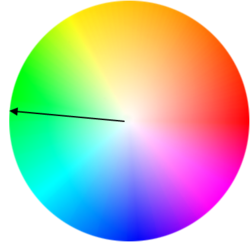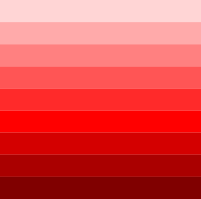Monochromatic color
Monochromatic colors are all the colors (tones, tints, and shades) of a single hue.
Monochromatic color schemes are derived from a single base hue and extended using its shades, tones and tints. Tints are achieved by adding white and shades and tones are achieved by adding a darker color, grey or black.

Monochromatic color schemes provide opportunities in art and visual communications design as they allow for a greater range of contrasting tones that can be used to attract attention, create focus and support legibility.
The use of a monochromatic color provides a strong sense of visual cohesion and can help support communication objectives through the use of connotative color. The relative absence of hue contrast can be offset by variations in tone and the addition of texture.[1]
Monochromatic in science means consisting of a single wavelength of light or other radiation (lasers, for example, usually produce monochromatic light), or having or appearing to have only one color (in comparison to polychromatic). That means according to science the true monochromatic images can be strictly created only of shades of one color fading to black.[2]
However, monochromatic also has another meaning similar to “boring” or “colorless” which sometimes leads to creating a design composed from true monochromatic color shades (one hue fading to black), and the colors created from the one hue but faded to all wavelengths (to white). This is not monochromatic in the strictly scientific meaning of the word. In fact, monochrome in the art world can be as complicated or even more complicated than other polychromatic art. [3]
Recommends for CUD
It is also recommended to use monochromatic color for Color Universal Design (CUD).[4] An image with enough contrast ratio monochromatic color also compatible with color blindness people.
Difference (confuse)
Red
|
Green
|
Same (high contrast)
Red
|
Light red
|
See also
- Color depth
- Color scheme
- Monochrome
References
- ↑ O'Connor, Z. (2014). Colour Combination Techniques. Sydney AUS: Design Research Associates.
- ↑ "the definition of monochromatic". http://dictionary.reference.com/browse/monochromatic.
- ↑ "The Absence of Color Symbolism of Black and White". https://perfectpicturelights.com/blog/the-absence-of-color-symbolism-of-black-and-white.
- ↑ "Color Universal Design (CUD) – How to make figures and presentations that are friendly to Colorblind people –". http://jfly.iam.u-tokyo.ac.jp/color/.



